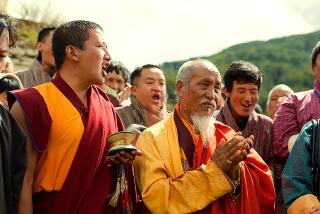The Wind Carries No Voice but Sorrow : Tibet: It’s not just a nation, but a notion--the half-mythic place of our loftiest imaginings. Today its faith and culture are on the brink of extinction. More than a million people have been killed, and more lies ahead.
Before I went to Tibet, I assumed that all the reports I had heard about the “Abode of Gods,” from Tibetans and their friends, were fairy tales or wishful thoughts. After I came back from Tibet, I was myself a fabulist. For the air itself, along those unearthly plateaus, seemed to vibrate with a fervor and intensity I had never seen, or even imagined. And its spirit was quite different from the pleasant calm one finds amid the other remote places of the High Himalayas, in the monasteries of Nepal or the desolate mountains of Bhutan. In Tibet, devoutness charged the air like windblown prayer flags.
I remember seeing pilgrims walking across the whole inhospitable breadth of the land to visit the sacred places of Lhasa. Old men and women labored up steep mountainsides to give what they had to monks. The square outside the Jokhang Temple was filled from dawn to midnight with votaries performing three-part prostrations. And once, when I gave a monk a picture of the exiled Dalai Lama, he wept.
Today, that faith, that culture, that intensity, are on the brink of extinction. All but 13 of Tibet’s 6,254 temples have been reduced to rubble by the Chinese. More than 1 million Tibetans have been killed. Monks are still being tortured, and nuns raped. Ganden Monastery, which bustled two generations ago with the chanting of lamas, the cut and thrust of debate, the jostle of a thriving city on a hill, is little more now than broken walls. The Drepung, once the largest monastery in the world, carries no voice but the wind’s.
The systematic desecration of Tibet has been continuing for 40 years. Now, though, an entirely new culture is being set up in its place. In order to adulterate the race, Beijing has flooded the area with Han Chinese, so that Tibetans are outnumbered in their capital by 3 to 1. The Jokhang is studded with the butts of AK-47s. In the shadow of the 13-story Potala Palace, the rulers have erected a Holiday Inn. The land once known as Shambhala is home to more than 300,000 soldiers; Shangri-La is now a nuclear-testing site.
Tibet, in fact, has lived under the shadow of martial law since three months before last year’s massacre in Beijing. And as March 10, the 31st anniversary of the Tibetan uprising, draws near, the cycle of rebellion and repression seems certain to start up again.
At stake, however, is something more than just a stretch of land. For Tibet has always been as much a symbol as a site. And today, Tibet is as much a notion, as a nation, under siege. For centuries, Tibet was the name we gave to our loftiest imaginings, that high, half-mythic place, not far below the heavens, where the air was pure and rarefied and the colors sharp.
For centuries, the country seemed hardly to exist on any map except that of the inner eye: Until 10 years ago, fewer than 2,000 Westerners had ever set foot in the Forbidden Land. For two millennia, Tibet was that magic realm three miles above the sea where a culture could live apart from the world, in peace; the place where God-Kings were discovered at the age of 2, and monks were said to run in trances for 60 miles or more. Tibet was the place where anything could happen. A down-to-earth Austrian mountaineer, Heinrich Harrer, escaped from his POW camp in India, stumbled into Tibet and ended up as tutor to the Living Buddha. Tibet was our lost horizon.
In that sense, Tibet has always been the property of us all, and all of us have cause to care about the rooftop of the world. If Tibet is destroyed, something precious inside us will be lost: a refuge, perhaps, or the hope that faith can hold out against cynicism, a peaceful theocracy survive even in the global village.
As what was once a wistful parenthesis in the world’s imagination becomes a bloody question-mark, it is not just two cultures, but two concepts, that are clashing in Tibet: the belief that everything must fit into some geopolitical equation, and the hope that something can exist apart from that, above it.
In the XIVth Dalai Lama, the Tibetans are blessed with one of the most winning and dignified leaders in the world today. Even skeptical journalists who come into contact with his mischievous warmth and good nature come away staunch Tibetans. And true to the Buddhist ideals of compassion and detachment, the man who calls himself “a simple Buddhist monk” has gone out of his way to bring balance to the tangled issue, acknowledging that his homeland had to pay the price for being too isolated from the world, refusing to cast blame upon its Chinese enemies. Almost alone among worldly (and unworldly) leaders, he has mastered the conference table without abandoning his hold on gentleness and principle.
The last time I talked to the Dalai Lama was in October, the day after he had been awarded the Nobel Prize for Peace. It was an exceptionally busy time for him and his small staff as they fielded requests, congratulations and suggestions from around the world. The Living Buddha had a thousand things to do.
Yet, when I burst in on him, he not only took time out, and whisked me off to a little room for a chat, but as soon as we entered, started bustling around to find me a soft cushion. The God-King refused to sit down until he had made the pestersome reporter comfortable. It was that simple gesture--a kindness natural as breathing--that moved me as much as anything he said. And it is that spirit that the guns would level.
More to Read
Sign up for Essential California
The most important California stories and recommendations in your inbox every morning.
You may occasionally receive promotional content from the Los Angeles Times.










